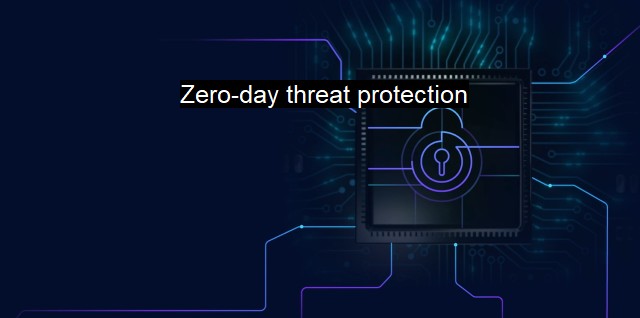What is Zero-day threat protection?
Securing Your Systems from Unseen Dangers: Zero-Day Threats and Vulnerabilities Explained
Zero-day threat protection is a fundamental element in cybersecurity practices and adjunct to antivirus software solutions. Understanding this concept begins with understanding what a "zero-day" vulnerability is. The term “zero-day” originates from the number of days a software vendor has knowledge of a security vulnerability in their software; hence a zero-day vulnerability is one that is unknown to the vendor. This means that the software contains underlying vulnerabilities that the vendor is unaware of, and therefore has not addressed or rectified. It is a glitch or weakness in the security system that hackers exploit before it can be noticed and fixed by the developers.Where does zero-day threat protection come into play in this context? Zero-day threat protection is an element of threat detection and response tools designed exclusively to cope with such zero-day vulnerabilities. It comprises of protective measures to detect, deter, and neutralize any risks posed by zero-day vulnerabilities. it aims to shield the computer systems or networks from the unknown or unpredictable dangers lurking in the expanding cyber domain.
Zero-day threat protection ensures that an appropriate defence mechanism is in place to protect crucial data, systems, and networks from potential breaches before a patch is released from the software company. These mechanisms adapt and evolve over time by learning from past vulnerabilities and malicious attacks. A significant part of achieving this involves evaluating and identifying suspicious and unidentified activity along the network to ensure criminals do not exploit lax security measures. Zero-day threat protection systems are reputed to improvise their response whenever a new or unexpected security threat comes to the fore. They can halt suspicious behaviours in real-time, thus modifying the course of action before any severe damage takes place. Consequently, the introduction of this system has improved the reactive and proactive strategies to combat cybersecurity issues.
Antivirus applications traditionally used signature-based detection. That meant they count on a database of known malware signatures to identify and thwart threats. zero-day threats are new and unknown, which means they are unlikely to carry any existing signature. Herein is where zero-day threat detection makes its mark; this form of defence mechanism uses predictive analysis and artificial intelligence to identify and tackle any strange or disruptive behaviours that indicate a potential data breach.
This mechanism focuses on thwarting the effort made to launch a zero-day attack by detecting the unseen or unconventional behaviours in the system. Embracing such advanced security solutions consolidates an organization's preventative measures, making it much more challenging for these harbingers of chaos to wreak havoc. Zero-day threat protection, consequently, catches the threats early and acts on them more quickly, mitigating significant risk and potential damage.
It’s essential to appreciate that zero-day protection is not a standalone mechanism; it operates best when combined with other technology layers. As advanced as this form of threat detection might appear, some threats might still slip through the initial barriers erected to minimize and control any severe risks. Thus, stakeholders are often advised to establish other security layers such as firewalls, intrusion prevention systems, and dedicated threat intelligence to offer robust security against any potential zero-day threats.
Zero-day threat protection plays an instrumental role in protecting systems from vulnerabilities previously unknown to software vendors, it helps to prepare, detect, and respond reducing the potential damage that might be incurred in the absence of prompt corrective actions. Regardless, it should be used in conjunction with other security measures for optimal cybersecurity.

Zero-day threat protection FAQs
What is a zero-day threat?
A zero-day threat is a newly discovered vulnerability or weakness in a software or system that is not yet known to the vendor or antivirus providers. Hackers exploit these vulnerabilities, which can cause severe harm to the system or network.What is zero-day threat protection?
Zero-day threat protection is a proactive cybersecurity approach that aims to detect and block unknown vulnerabilities or exploits. This protection uses advanced machine learning techniques and behavioral analysis to identify and mitigate zero-day attacks.How do I protect my system from a zero-day threat?
To protect your system from zero-day threats, you must keep your antivirus software up-to-date. Additionally, you should regularly scan your system, avoid suspicious links and downloads, and implement security policies that restrict unauthorized access. It's also good practice to stay informed about the latest vulnerabilities and update your software as soon as possible.Is zero-day threat protection necessary for businesses?
Yes, zero-day threat protection is essential for businesses to protect their sensitive data and systems. Businesses are frequently targeted by cybercriminals, and zero-day attacks can cause severe damage to the organization's reputation and finances. By implementing zero-day threat protection, businesses can safeguard their infrastructure from emerging threats and mitigate the risk of a cyber-attack.| | A | | | B | | | C | | | D | | | E | | | F | | | G | | | H | | | I | | | J | | | K | | | L | | | M | |
| | N | | | O | | | P | | | Q | | | R | | | S | | | T | | | U | | | V | | | W | | | X | | | Y | | | Z | |
| | 1 | | | 2 | | | 3 | | | 4 | | | 7 | | | 8 | | |||||||